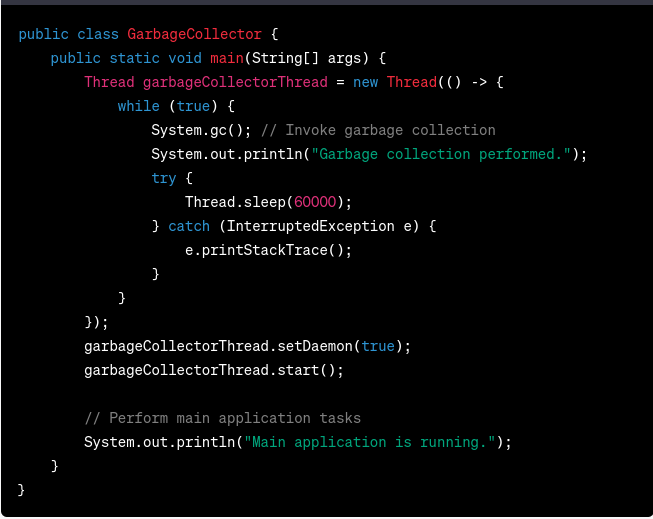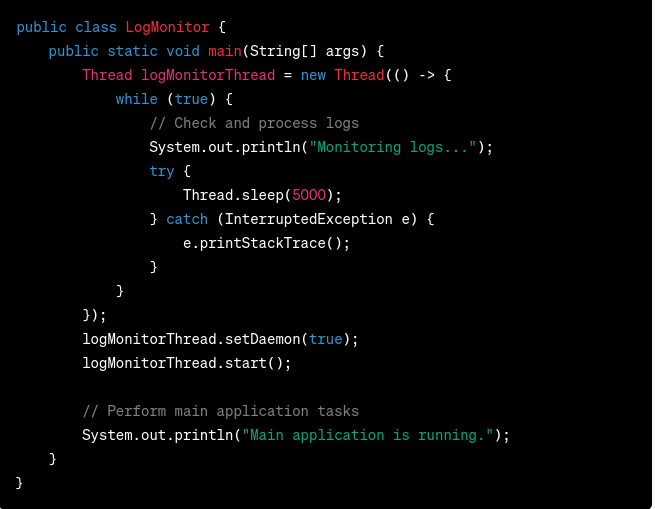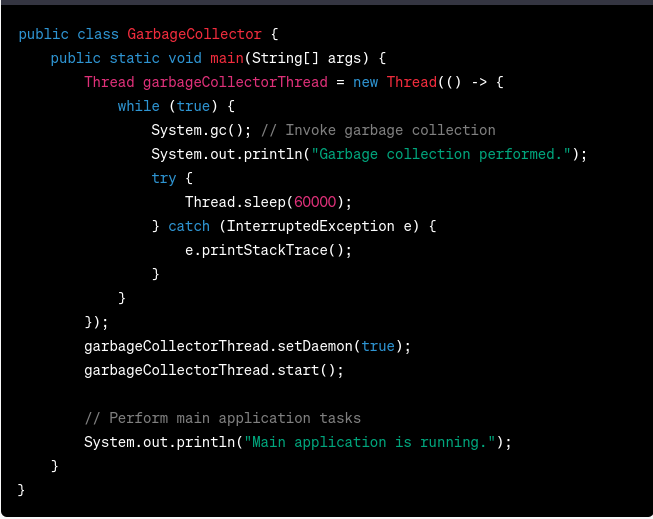Introduction:
In the realm of Java multithreading, the concept of daemon threads plays a vital role. Daemon threads are a special type of thread that runs in the background and provides support services to non-daemon threads. Understanding the behavior and characteristics of daemon threads is crucial for writing efficient and scalable Java applications. In this article, we will delve into the world of daemon thread in Java, exploring its definition, default nature, methods, examples, and how it differ from user threads.
Overview:
Java threads form the cornerstone of concurrent programming, facilitating the execution of multiple tasks in unison within one program. Among these threads, Daemon threads stand out, bearing distinct traits when compared to user threads. These threads cater to auxiliary services and are designed to cease functioning once all non-daemon threads have concluded their operations. Let's explore the Daemon thread in Java with examples to unravel its nature in more detail.
What is Daemon Thread in Java?
A daemon thread is a thread that runs in the background and does not prevent the Java Virtual Machine (JVM) from exiting when all non-daemon threads in Java have been completed. These threads are typically used to perform background tasks such as garbage collection, monitoring, and other system-level operations. Daemon threads are created using the `setDaemon(true)` method of the `Thread` class.
Let's understand this concept through an example:

Output:

Explanation:
In the above example, we create a daemon thread that runs an infinite loop and prints a message every second. Since it is a daemon thread, it doesn't prevent the JVM from exiting when the main thread completes its execution. Thus, the program terminates immediately after printing the "Main thread is exiting." message.
When There is No User Thread, Why Does JVM Stop the Daemon Thread in Java?
Even though daemon threads do not impede the JVM from terminating, they are automatically stopped when there are no user threads running. The rationale behind this behavior lies in the fact that daemon threads are meant to provide supporting services to non-daemon threads. When all non-daemon threads complete, there is no need to continue the execution of daemon threads as they primarily exist to assist the application's main functionality.
Default Nature of Daemon Thread
By default, threads created in Java are user threads. This means that the JVM waits for user threads to complete before terminating the program. On the other hand, daemon threads, as mentioned earlier, do not prevent the JVM from exiting. The default nature of threads can be altered using the `setDaemon(boolean)` method of the `Thread` class.
Properties of Daemon Thread in Java Studytonight:
Daemon threads possess several properties that distinguish them from user threads. Let's explore these properties:
1. Execution in the Background: Daemon threads run in the background, performing tasks that do not require user interaction.
2. Termination on Program Exit: Daemon threads are automatically terminated when all non-daemon threads have completed their execution.
3. Supporting Role: Daemon threads exist to provide auxiliary services to user threads, such as garbage collection, logging, or monitoring.
Methods for Daemon Thread in Java by Thread Class:
The `Thread` class provides several methods to control and manage daemon threads. Let's discuss some of the commonly used methods to understand how to create Daemon thread in Java:
1. `setDaemon(boolean)` - Sets the thread as a daemon thread if the argument is true.
2. `isDaemon()` - Checks if the thread is a daemon thread.
3. `getId()` - Returns the unique identifier of the thread.
4. `getPriority()` - Returns the priority of the thread.
Daemon Thread in Java Example:
To further solidify our understanding, let's explore a couple of practical examples involving daemon threads:

Output:

Explanation:
In this example, we create a daemon thread responsible for monitoring logs in the background. It continuously checks for new log entries and performs the necessary processing. Meanwhile, the main application carries out its tasks independently.
Example 2: Daemon Thread for Garbage Collection

Output:

Explanation:
In this example, we create a daemon thread responsible for invoking garbage collection at regular intervals. It performs the necessary cleanup operations in the background, ensuring optimal memory usage for the main application.
Exceptions in a Daemon Thread in Java:
Daemon threads can encounter exceptions just like any other thread. However, if an exception occurs in a daemon thread and it is not caught and handled, it can cause the JVM to terminate abruptly. It is essential to handle exceptions appropriately to prevent an unexpected termination of the program.
How to Stop Daemon Thread in Java?
To halt a daemon thread in Java, do the following:
1. Define a termination condition: Define a condition that specifies when the daemon thread's execution should be terminated.
2. Check the termination condition: Check the termination condition within the daemon thread's code on a regular basis.
3. Terminate the thread gracefully: When the termination condition is met, terminate the thread's execution loop and conduct any necessary cleanup.
It should be noted that daemon threads are intended to offer supporting services and are stopped once all non-daemon threads have concluded. As a result, halting a daemon thread should be done carefully to ensure appropriate termination and to avoid unexpected behavior in your application.
Daemon Thread vs. User Thread:
User threads and daemon threads have various properties and are used for different things in Java applications. Let's examine some further comparisons between these two thread types:
1. JVM Termination
- Daemon Threads: Daemon Threads Have No Effect on JVM Termination. Daemon threads do not stop the JVM from shutting down. Regardless of any lingering daemon threads, the JVM shuts down once all non-daemon threads have finished running.
- User Threads: User threads keep the Java Virtual Machine (JVM) running while they are being executed. Before shutting down, the JVM waits for all user threads to complete.
2. Application Termination:
- Daemon Threads: Daemon threads are frequently employed for auxiliary services and background chores. Daemon threads are suddenly terminated once all non-daemon threads have finished since they are viewed as incidental to the application's primary operation.
- User Threads: The main functionality of the application is carried out by user threads. The program keeps running until all user threads have completed their tasks.
3. The type of work:
- Daemon Threads: Daemon threads are made for background-running, non-essential jobs. They carry out duties like trash pickup, logging, or monitoring. Critical operations typically do not involve daemon threads.
- User Threads: The primary functionality of the application is handled by user threads. They are in charge of carrying out crucial duties, carrying out calculations, and engaging with users.
4. Synchronization and Control:
- Daemon Threads: Daemon threads are not frequently utilized for explicit control mechanisms or synchronization. They frequently function independently and are not meant to coordinate with other threads.
- User Threads: To maintain effective coordination and control between threads, user threads frequently need synchronization techniques like locks, semaphores, or monitors.
5. Error Handling:
- Daemon Threads: To prevent unexpected application termination, daemon threads should handle exceptions effectively. Daemon thread exceptions that go uncaught can cause the JVM to crash.
- User Threads: To handle exceptions and keep the program stable, user threads need to have strong error handling capabilities. To avoid program crashes, unhandled exceptions in user threads can be caught, logged, or handled.
You may successfully employ each kind according to its intended purpose by understanding the distinctions between daemon threads and user threads. This will help you create multithreaded programs that are well-designed and effective.
Why JVM Terminates the Daemon Thread if There is No User Thread?
When all non-daemon threads complete their execution, the JVM assumes that the application's main functionality is over. As daemon threads primarily exist to support user threads, they are terminated to avoid unnecessary resource consumption and to allow the JVM to exit gracefully.
Non-Daemon Thread in Java:
Non-daemon threads are the default type of threads in Java. Unlike daemon threads, non-daemon threads prevent the JVM from terminating until they complete their execution. They are typically used for crucial tasks and operations that require explicit handling and synchronization.
Daemon threads run in the background, separate from the main execution flow of the program. They continue their execution as long as there are non-daemon threads actively running. Once all non-daemon threads are complete, the JVM terminates, along with any remaining daemon threads.
Conclusion:
Daemon threads in Java serve as essential components for performing background tasks and providing auxiliary services. Their distinct behavior and properties make them ideal for tasks such as garbage collection, monitoring, and other system-level operations. By understanding the nature of daemon threads and utilizing them effectively, you can enhance the efficiency and responsiveness of your Java applications. You can also implement the learnings from this discourse to use Daemon Thread in Java in Hindi or other supported languages.
As a ready-reckoner, refer to the critical takeaways from this article:
- Daemon threads are intended to perform background functions such as trash collection, logging, and monitoring. They are not intended for mission-critical tasks that necessitate explicit control and synchronization.
- Daemon threads have no effect on the JVM's termination. When all non-daemon threads have completed their execution, the JVM, including any remaining daemon threads, terminates.
- Daemon threads should be used with caution, taking into account the specific needs of your application. They are ideally suited for tasks that can be completed separately without relying on the completion of other threads.
- Communication-based approaches, such as using flags or messages to signal the thread to end its execution, can be used to gracefully terminate daemon threads. This ensures adequate cleanup and avoids an abrupt end.
- To avoid unexpected application termination, daemon threads should handle exceptions appropriately. Uncaught exceptions on daemon threads can propagate to the default uncaught exception handler, causing the JVM to crash.
- You may improve the efficiency and responsiveness of your Java programs while guaranteeing correct control and synchronization amongst threads by successfully utilizing daemon threads and understanding their properties.
- Remember to carefully evaluate the nature of your jobs and select the right thread type (daemon or user) in your multithreaded applications to get the desired behavior and functionality.
FAQs:
1. What happens if an exception occurs in a daemon thread and is not handled?
If an exception occurs in a daemon thread and is not caught and handled, it can cause the JVM to terminate abruptly.
2. Are daemon threads suitable for critical tasks in an application?
Daemon threads are typically not recommended for critical tasks in an application. They are designed to provide supporting services and are terminated when all non-daemon threads are complete. Critical tasks often require explicit control, synchronization, and error handling, which are better suited for non-daemon threads.
3. What are some common use cases for daemon threads in Java?
Daemon threads are frequently used for background logging, periodic maintenance, event listeners, and supporting services like timers and schedulers. They provide constant support for the application's principal functionality without interfering with its execution.
Take the Free Quiz on Java
Answer quick questions and assess your Java knowledge



-7f4b4f34e09d42bfa73b58f4a230cffa.webp&w=128&q=75)
-7f4b4f34e09d42bfa73b58f4a230cffa.webp&w=128&q=75)


























-ae8d039bbd2a41318308f8d26b52ac8f.svg)







-9cd0a42cab014b9e8d6d4c4ba3f27ab1.webp&w=3840&q=75)





